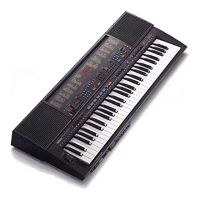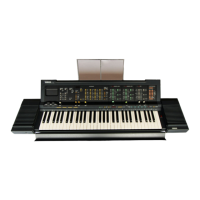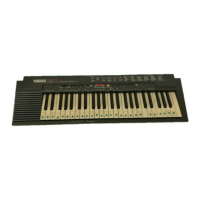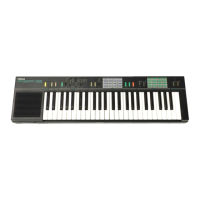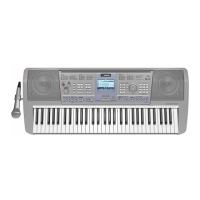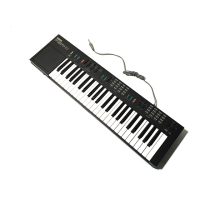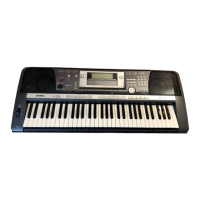
Do you have a question about the Yamaha PortaTone PSR-640 and is the answer not in the manual?
| Brand | Yamaha |
|---|---|
| Model | PortaTone PSR-640 |
| Number of Keys | 61 |
| Styles | 100 |
| Display | LCD |
| Effects | Reverb, Chorus, DSP |
| Polyphony | 32 |
| MIDI | In/Out |
| Speakers | 12cm x 2 |
| Connections | MIDI In/Out |
| Power Supply | PA-5 AC Adapter or batteries |
Details about product specifications, environmental concerns, and nameplate information.
General environmental information regarding Yamaha's commitment to user safety and eco-friendliness.
Information on where to find the product's name plate for model and serial number details.
Essential safety warnings and cautions to prevent injury or damage to the instrument and property.
Advice on how to frequently save user data to prevent loss due to malfunctions or errors.
Guides on setting up the keyboard, including power supply and connections.
An overview of the significant features and functions of the PSR-740/640 keyboard.
Guidance on understanding and using the keyboard's panel controls and display indications.
Fundamental operations for using the keyboard's functions and displays.
Instructions on how to play and control the built-in demonstration songs.
Explanation of various icons and indicators shown on the instrument's main display.
A chart detailing buttons, functions, and corresponding page numbers for easy navigation.
Detailed layout and functions of the keyboard's top panel controls.
Detailed layout and functions of the keyboard's rear panel controls and terminals.
Instructions for connecting the power supply and optional footswitches.
Guides for connecting audio output, headphones, and microphones.
Instructions for connecting external MIDI devices and the music stand.
Explanation of various icons and indicators shown on the instrument's main display.
Procedures for accessing and exiting various instrument displays and menus.
How to access help messages and select their display language.
Guidance on navigating through the instrument's menus for various operations.
Methods for setting and modifying numeric values for parameters and settings.
How to name data for songs, styles, and registration memory.
How to use the keyboard in Style mode for playing and auto accompaniment.
How to use the keyboard in Song mode for playing and managing songs.
How to use the keyboard in Record mode to create original performances and data.
How to use the keyboard in Disk mode for saving and loading data.
Guide on choosing and playing single instrument voices from the keyboard.
How to layer two voices (R1 and R2) for a fuller sound.
How to use the split keyboard function to play different voices with each hand.
Explanation of how to set the split point for dividing the keyboard.
Explanation of keyboard functions like Split Point, Auto Accompaniment, and Naming.
How to use Transpose, Pitch Bend, and Modulation Wheel for performance expression.
Instructions for using the Sustain effect and playing keyboard percussion sounds.
Details on parameters for creating custom organ voices on the PSR-740.
Step-by-step guide to editing and adjusting Organ Flutes parameters.
Basic usage of auto accompaniment for rhythm tracks only.
Full usage of auto accompaniment with all tracks enabled.
Explanation of Intro, Main, Fill-in, and Ending sections in auto accompaniment.
How to set and adjust the tempo using the TEMPO/TAP button.
Controlling individual accompaniment tracks and overall volume balance.
How to play chords for accompaniment and details on fingering modes.
Setting the split point for the auto accompaniment section.
How to use the Synchro Stop function for accompaniment control.
Using OTS to instantly reconfigure panel settings and a list of its parameters.
How to temporarily alter the "feel" of accompaniment using Groove and Dynamics.
Customizing Groove Type, Swing, Dynamics Type, and Depth.
How to use the Multi Pads to play pre-recorded phrases.
Feature linking Multi Pads to chords for transposition.
How to select different banks of Multi Pad phrases.
How to enable or disable the Chord Match function.
Explanation of the Reverb effect and how to select types.
Explanation of the Chorus effect and how to select types.
Explanation of the DSP effect and how to select types.
Explanation of the Harmony/Echo effect and how to select types.
Explanation of the Master EQ for tone control on the PSR-740.
How to modify the depth and return level of the Reverb effect.
How to select Chorus types and adjust their depth and return level.
How to apply DSP effects, select types, and adjust their depth.
Explanation of different types of digital effects: system and insertion.
Details on the Multi Effects system for the PSR-740.
How to configure and apply Multi Effects to voices.
How to select the desired Harmony/Echo effect types.
How to apply the Harmony/Echo effect while playing.
Guide to using the Master EQ for tone control and selecting preset types.
How to manually adjust the gain of each frequency band in the equalizer.
Overview of the Registration Memory feature and the data it stores.
How to save and recall panel settings, and use the Freeze function.
Procedures for selecting and naming banks of registration settings.
Information on disk formats compatible with the PSR-740/640 for song playback.
Information on disk formats compatible with the PSR-740/640 for style playback.
How to record and play back user-created songs.
How to create, save, and load user styles.
Chart detailing data types savable and loadable from floppy disks.
Overview of additional disk operations like Format, Copy, and Delete.
Instructions for using the included sample disk.
Steps for inserting and playing songs from a disk.
How to prepare commercially available floppy disks for use.
How to save User styles, pads, and registration memory to disk.
How to copy song data, including between floppy disks.
Steps for copying data to a different location on the same floppy disk.
Explains different ways to play back songs from disk (e.g., Single, All, Random).
Lists other functions related to song playback like track muting and transpose.
Steps for inserting a disk and selecting a song to play.
How to mute individual tracks within a song.
How to adjust the volume of a song playback.
Steps for setting up the microphone and input volume.
Alternative input setup using LINE sources for Vocal Harmony.
How to turn on and use the Vocal Harmony effect while playing.
Guide to adjusting harmony type, lead gender, and pitch correction.
Details on parameters like type, gender, and modes for Vocal Harmony.
How to adjust Talk Volume, Total Volume, DSP, and Vocal Harmony types.
How to change the voices for individual parts like R1, R2, L, and tracks.
How to adjust the volume and balance of individual parts.
How to edit parameters like Octave, Pan, Reverb, Chorus, and DSP depth.
How to quickly and easily record a song without detailed settings.
How to record up to sixteen tracks independently and re-record parts.
How to selectively re-record a portion of a song track.
How to determine the measure at which recording starts.
Post-recording adjustments including Quantize and Setup Data Editing.
How to name and delete recorded User Songs.
Information on what data types can be recorded to User songs.
Details on performing Multi Track Recording, including track assignments.
Details on performing Quick Recording, including track assignments.
How to start, stop, and save recorded data during Quick Recording.
How to start, stop, and save recorded data during Multi Track Recording.
How to re-record specific sections of a song using Punch In/Out.
Information on what data can be recorded to User Pads.
How to record custom Multi Pad phrases.
How the Chord Match feature links Multi Pads to chords.
How to name custom Multi Pad data.
How to delete custom Multi Pad data.
Information on the structure of User Styles.
Details on the types of data that can be recorded to User Styles.
Specifics on recording user styles, including loop and overdub methods.
How to use existing preset styles as a base for creating user styles.
Information on the Style File Format and CTAB parameters.
Detailed explanation of CTAB parameters for style accompaniment.
Procedures for exiting the style recording mode.
How to record non-rhythm tracks for styles.
How to name custom User Styles.
How to delete custom User Style data.
How to configure CTAB parameters like Note Limit, High Key, and Source Chord.
Basic explanation of MIDI technology and its role in music.
Explanation of Channel/System messages and MIDI/TO HOST terminals.
How to use MIDI for tone generation, sequencing, and recording.
Information on data formats like SMF, ESEQ, XF, and voice allocation standards.
Instructions for connecting the keyboard to a PC using MIDI terminals.
Instructions for connecting the keyboard to a PC using the TO HOST terminal.
How to use MIDI templates for quick configuration of settings.
A list of available MIDI templates and their configurations.
How to configure MIDI transmit channels and tracks.
How to configure MIDI receive channels and modes.
How to manage local control and external MIDI clock synchronization.
How to transmit current panel settings to another device.
How to use and configure the metronome.
Adjusting octave, master tuning, and scale tuning settings.
How to set the split point for keyboard sections.
How to adjust keyboard touch response.
How to configure Voice Set for optimal voice performance.
How to assign various functions to the footswitch.
How to assign functions to the foot volume controller.
How to set the pitch bend range for the wheel.
How to assign functions to the modulation wheel.
List of all available voices, including panel, XG, and organ flute voices.
Details on panel voices, XG voices, and drum kits for both models.
Information on the maximum number of notes that can sound simultaneously.
Detailed list of panel voices for the PSR-740 model.
Detailed list of panel voices for the PSR-640 model.
Detailed list of XG voices available on the instrument.
A comprehensive list of available drum kits and their assignments.
A catalog of all available auto accompaniment styles.
A list of available Multi Pad banks and their settings.
Explanation of how Reverb, Chorus, and DSP effects are implemented.
Lists of available Reverb types.
Lists of available Chorus types.
List of DSP types available for the PSR-640.
Comprehensive list of DSP types available on the PSR-740.
Detailed list of DSP types for specific blocks on the PSR-740.
A list of available Harmony and Echo effect types.
A list of all available Vocal Harmony types for the PSR-740.
How to back up panel settings retained in memory.
How to reset all data to factory presets.


